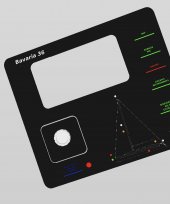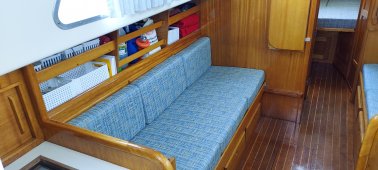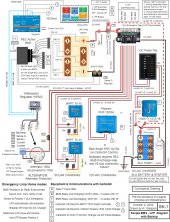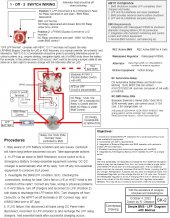One last minor tweak... I would swap the order of your disconnect and your Class T fuse on the LiFePO4. The Class T should be within about 8 inches of your battery positive terminal.Revision 10-3-2022 adding disconnects at both batteries, moving alternator shunt to positive.
Hopefully this is 98% complete. Thank you Goboatingnow, svsagres and wholybee. I could not have gotten this far without all your help! It is a great feeling to have some confidence about this diagram due help from to my excellent teachers!
View attachment 114638View attachment 114639
You are using an out of date browser. It may not display this or other websites correctly.
You should upgrade or use an alternative browser.
You should upgrade or use an alternative browser.
Small Boat BMS/LFP with backup
- Thread starter rgleason
- Start date
Goboatingnow
Solar Enthusiast
- Joined
- Jul 3, 2022
- Messages
- 1,325
At this stage further work might be “ gliding the Lilly “ 
Goboatingnow
Solar Enthusiast
- Joined
- Jul 3, 2022
- Messages
- 1,325
I’m also sick of the nonsense on cruisersforum from groups just pedalling a perspective.
Goboatingnow
Solar Enthusiast
- Joined
- Jul 3, 2022
- Messages
- 1,325
I have a concept block diagram tomorrow. But thanks for the offerI've seen that, they will come around eventually, but there sure are a lot of opinions, some very strong.
Would you like me to try to draw a diagram of your bms concept? Would love to learn more.
Refer to the CF Thread post #107
Jedi has convinced me to remove the LFP Override Switch for the reasons given in that post.
We are concerned that small boat owners will simply override to save energy and heat.
It will make ABYC, Jedi, Goboatingnow and svsagres a bit happier.
I still don't know how I am going to fit everything, and I need to pare it down anyway to reduce cost, if it is going to be considered as a small boat solution.
Jedi has convinced me to remove the LFP Override Switch for the reasons given in that post.
We are concerned that small boat owners will simply override to save energy and heat.
It will make ABYC, Jedi, Goboatingnow and svsagres a bit happier.
I still don't know how I am going to fit everything, and I need to pare it down anyway to reduce cost, if it is going to be considered as a small boat solution.
In all, I think I’m about $8000 or so in for the upgrade on my boat. They thing that adds up really quickly, a little at a time, it’s the wiring. I mostly stuck to 2/0 for my main conductors, 0AWG for sub-main, and 10 or 12 for everything else. Plus, I rebuilt the 120VAC with a couple of ELCI breakers, the multiplus, and a galvanic isolator.Refer to the CF Thread post #107
Jedi has convinced me to remove the LFP Override Switch for the reasons given in that post.
We are concerned that small boat owners will simply override to save energy and heat.
It will make ABYC, Jedi, Goboatingnow and svsagres a bit happier.
I still don't know how I am going to fit everything, and I need to pare it down anyway to reduce cost, if it is going to be considered as a small boat solution.
On the flip side, we can put the sous vide circulator in a bucket at the dock, start cooking the ribs as we leave, and have the best ribs you can imagine by the time we drop hook for the day.
Goboatingnow
Solar Enthusiast
- Joined
- Jul 3, 2022
- Messages
- 1,325
It’s a nonsense argument that 3AH would cause someone to switch out the BMS. sorry Nick is way way off beam here.Refer to the CF Thread post #107
Jedi has convinced me to remove the LFP Override Switch for the reasons given in that post.
We are concerned that small boat owners will simply override to save energy and heat.
It will make ABYC, Jedi, Goboatingnow and svsagres a bit happier.
I still don't know how I am going to fit everything, and I need to pare it down anyway to reduce cost, if it is going to be considered as a small boat solution.
If you are concerned about inadvertent use use a locking switch and hide the keys.
The 1-2 switch with electrical overrides is so sweet an idea. I’m going to build it into my install.
Changing out the switch for the reason system is just junk engineering. It’s nonsense. It has no technical merit.
I suggest you remove every fire extinguisher from your boat where someone finds their coffee is too hot.
Goboatingnow
Solar Enthusiast
- Joined
- Jul 3, 2022
- Messages
- 1,325
The RGleason solution involves a low cost standard 2 way battery switch with very safety orientated cheap electrical interlocksIn all, I think I’m about $8000 or so in for the upgrade on my boat. They thing that adds up really quickly, a little at a time, it’s the wiring. I mostly stuck to 2/0 for my main conductors, 0AWG for sub-main, and 10 or 12 for everything else. Plus, I rebuilt the 120VAC with a couple of ELCI breakers, the multiplus, and a galvanic isolator.
On the flip side, we can put the sous vide circulator in a bucket at the dock, start cooking the ribs as we leave, and have the best ribs you can imagine by the time we drop hook for the day.
And a cheap TE relay.
Replacing that to actually achieve only one gain ie lower power draw while loosing several advantages makes no sense. Also the ML is so much more expensive.
The second battery safety switch is a good idea anyway. It’s also cheap.
Yeah, I wasn’t really pushing for that. Though I got the ML for about $220 and it only draws 7mA to hold. My point was that a significant part of the cost was the wire/cable and terminations, plus the 120v portion of my upgrade. Copper isn’t cheap, and it adds up quickly especially with large conductors.The RGleason solution involves a low cost standard 2 way battery switch with very safety orientated cheap electrical interlocks
And a cheap TE relay.
Replacing that to actually achieve only one gain ie lower power draw while loosing several advantages makes no sense. Also the ML is so much more expensive.
The second battery safety switch is a good idea anyway. It’s also cheap.
Now I am liking the idea of a keyed switch.If you are concerned about inadvertent use use a locking switch and hide the keys.
I should estimate those costs too. I need to add ELCI and new shore connection as we have no AC panel, then I could connect the two 120vac plugs, refrig and domestic hot water heater, but we would never use it because we are on a mooring. However we should have the ELCI. Standards have changed.The thing that adds up really quickly, a little at a time, it’s the wiring. I mostly stuck to 2/0 for my main conductors, 0AWG for sub-main, and 10 or 12 for everything else. Plus, I rebuilt the 120VAC with a couple of ELCI breakers, the multiplus, and a galvanic isolator.
Goboatingnow
Solar Enthusiast
- Joined
- Jul 3, 2022
- Messages
- 1,325
Definitely fit while boat ELCI or RCBOs as they are known. There are fitted every where here in Europe. Also fit either an isolating transformer or at very least a galvanic isolator as US boat codes can promote stray current corrosion.Now I am liking the idea of a keyed switch.
I should estimate those costs too. I need to add ELCI and new shore connection as we have no AC panel, then I could connect the two 120vac plugs, refrig and domestic hot water heater, but we would never use it because we are on a mooring. However we should have the ELCI. Standards have changed.
I’m redoing all my control panels

Here the panel in real life
Attachments
Goboatingnow
Solar Enthusiast
- Joined
- Jul 3, 2022
- Messages
- 1,325
For an ELCI, you don't need a marine specific one. They're realistically just a ground-fault breaker with a 30mA leakage limit (domestic ones for your bathroom etc... have a 5mA limit). The breaker we used was an ASI NDB1L-32C-32-120V which we purchased from Amazon for $45 Canadian. It's UL Listed, is a double pole breaker, and otherwise meets all the AYBC requirements while costing 1/3 the Blue Sea price. We stuck it in a $15 small DIN electrical box, and we added a couple of Blue Sea 120V LED indicators to give us both "power present" indicators and "reverse polarity" indicator. These were just wired to the breaker and ground lug, and we drilled holes in the DIN box to house the LEDs.Now I am liking the idea of a keyed switch.
I should estimate those costs too. I need to add ELCI and new shore connection as we have no AC panel, then I could connect the two 120vac plugs, refrig and domestic hot water heater, but we would never use it because we are on a mooring. However we should have the ELCI. Standards have changed.
Given that the official Blue Sea version costs $267 from Fisheries Supply, the ASI breaker mentioned above was definitely the way to go. In your situation, you could actually get yourself a larger DIN breaker box and use other DIN breakers for your branch circuit for something neat and tidy.
We actually use a second one after our MultiPlus, as we didn't want to run 6AWG between the MultiPlus and our 3 circuit AC panel, as in theory our system could supply 50A worth of power. The second breaker, which should never trip, acts as both a full disconnect on the MultiPlus and protects the 10AWG feed from the MultiPlus to our main panel. But this doesn't apply to you due to your lack of an inverter/charger.
Cool custom boards with Lin!
Thanks for the ELCI suggestion, big saver!
WAY LATER: See Nick's good suggestions in CF https://www.cruisersforum.com/forum...for-isolation-on-boat-270442.html#post3707926
WAY LATER: CF Post #59
Question: If an electric car has an onboard inverter, does that mean it could also work in reverse? ..to temporarily power a house?
Thanks for the ELCI suggestion, big saver!
I think I would fit this in the port cockpit locker using a IP67 waterproof box with a WP door.ELCI, you don't need a marine specific one. They're realistically just a ground-fault breaker with a 30mA leakage limit (domestic ones for your bathroom etc... have a 5mA limit). The breaker we used was an ASI NDB1L-32C-32-120V which we purchased from Amazon for $45 Canadian. It's UL Listed, is a double pole breaker, and otherwise meets all the AYBC requirements while costing 1/3 the Blue Sea price. We stuck it in a $15 small DIN electrical box, and we added a couple of Blue Sea 120V LED indicators to give us both "power present" indicators and "reverse polarity" indicator. These were just wired to the breaker and ground lug, and we drilled holes in the DIN box to house the LEDs. ...or Amazon ASI NDB1L-32C-32-120V $34!
WAY LATER: See Nick's good suggestions in CF https://www.cruisersforum.com/forum...for-isolation-on-boat-270442.html#post3707926
WAY LATER: CF Post #59
Question: If an electric car has an onboard inverter, does that mean it could also work in reverse? ..to temporarily power a house?
Last edited:
That's what we've done. When you open the Lazarette, there's a little breaker box on the aft end, within a few inches of our shorepower inlet. The AC goes there, with the ground conductor taking a loop through our Galvanic Isolator, then goes out to the input on our inverter/charger. It's tight, clean, and puts the main disconnect/reconnect right next to the shorepower connector.Cool custom boards with Lin!
Thanks for the ELCI suggestion, big saver!
I think I would fit this in the port cockpit locker using a IP67 waterproof box with a WP door.
Question: If an electric car has an onboard inverter, does that mean it could also work in reverse? ..to temporarily power a house?
As far as your question regarding Electric Vehicles, it can be done, there's a few makers that have advertised being able to use your car as a "whole home UPS". I work with a non-profit that has their own private electrical grid (small 250kW hydro-electric plant, high voltage distribution) and we've been looking at converting our vehicle fleet (half dozen school busses primarily) to electric propulsion, but also being able to use them for grid support when they're plugged in overnight.
EVE LF100 $75-85
Stacked 3 high for 300ah it would be a box about 8" x 10" x 18" high
Relays, BMS, disconnect switches and 1-0ff-2 switch under a lid in the top.
Sides would have some vents for air flow.
Each stack accessible from a door in the front perhaps with a slide out tray?
The box would have two handles to take it home during the winter.
3x16.75 lbs=50.25 lbs
The box could fit on the cabin sole under the folded up table, attached to the head bulkhead.
Wires could run along the top of the keel water tank and up to the box.

Now it looks like a box 18" high would interfere with sliding out the berth.
Will need to find a better location.
160l x 50w x 119h,
6.3"l x 2"w x 4.7"high
so (4) 6.3"x8"x 4.7"high
Standard Charge / discharge current: 0.5C/0.5C
Operating Voltage: 2.5V~3.65V
Maximum continuous charge/discharge current: 1C/1C
Maximum pulse charge/discharge current(30s): 2C/2C
1.9kg 4x1.9kg=7.9kg =16.75 lbs
Stacked 3 high for 300ah it would be a box about 8" x 10" x 18" high
Relays, BMS, disconnect switches and 1-0ff-2 switch under a lid in the top.
Sides would have some vents for air flow.
Each stack accessible from a door in the front perhaps with a slide out tray?
The box would have two handles to take it home during the winter.
3x16.75 lbs=50.25 lbs
The box could fit on the cabin sole under the folded up table, attached to the head bulkhead.
Wires could run along the top of the keel water tank and up to the box.

Now it looks like a box 18" high would interfere with sliding out the berth.
Will need to find a better location.
EVE LF100 $75-85
Stacked 3 high for 300ah it would be a box about 8" x 10" x 18" high
Relays, BMS, disconnect switches and 1-0ff-2 switch under a lid in the top.
Sides would have some vents for air flow.
Each stack accessible from a door in the front perhaps with a slide out tray?
The box would have two handles to take it home during the winter.
3x16.75 lbs=50.25 lbs
The box could fit on the cabin sole under the folded up table, attached to the head bulkhead.
Wires could run along the top of the keel water tank and up to the box.
View attachment 115319
Now it looks like a box 18" high would interfere with sliding out the berth.
Will need to find a better location.

I know you've seen this picture before, but that's how I have mine setup. I'm pretty much using every possible mounting spot in an otherwise unused void under our aft quarterberth. Previously our Lead Acid batteries were in there. Anyhow, the key things to note is the positive wires comming out of the top of the battery (near the top of the photo) can't physically reach any exposed negative cabling. Everything else is protected by the Class T fuse (under the cover). The battery box itself now has a plexiglass cover (a friend of ours owns a small store, and were disposing of their COVID shield, so we cut it down and used the plexi as a cover).
The batteries themselves are the 230Ah EVE which fit nicely in the hole, in a 2p4s configuration. We had to build up the stack in situ.The cells themselves are sitting on plastic pool deck tile, to lift them 1/4" up from the bottom of the box and allow any potential moisture to drain out.
Similar threads
- Replies
- 12
- Views
- 304
- Replies
- 42
- Views
- 1K






